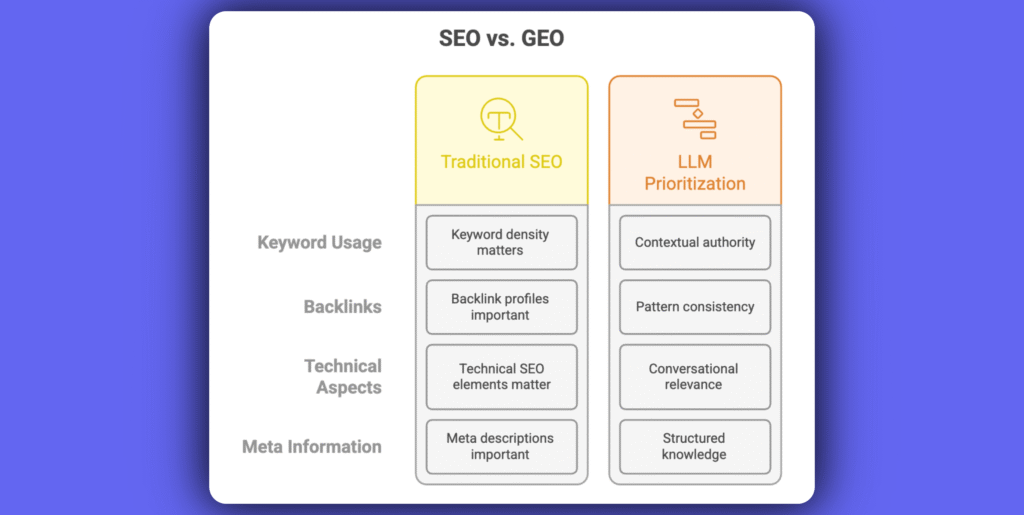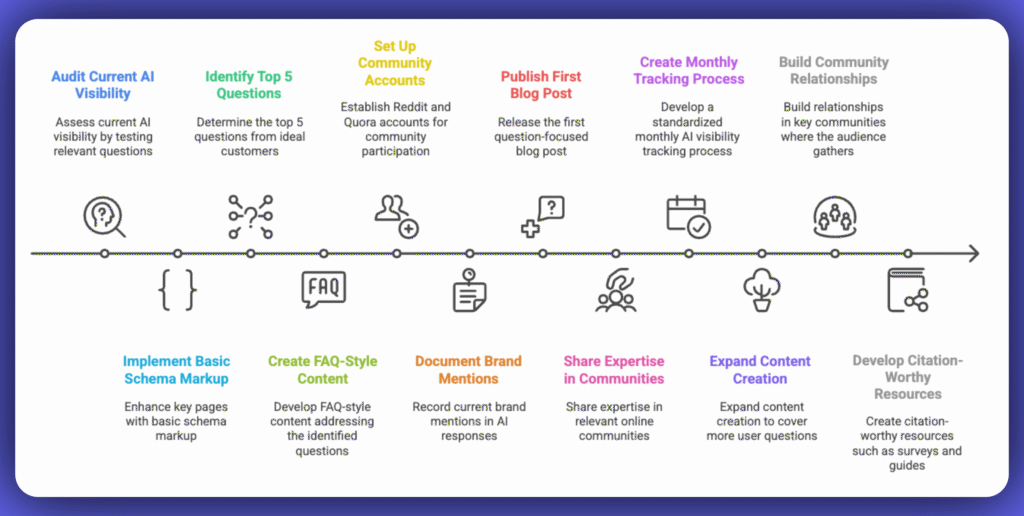Traditional SEO is built for keyword-ranking in indexed search engines. GEO (Generative Engine Optimization) is built for visibility inside LLMs, which use pattern recognition, training data, and context instead of keyword-matching or backlinks. If you’re not optimizing for LLMs like ChatGPT, Claude, and Perplexity, you’re invisible in AI-driven discovery, and that’s where your customers are increasingly looking for answers.
As a SaaS founder or marketer, you’ve probably noticed something shifting. Your customers aren’t just Googling “best project management software” anymore. They’re asking ChatGPT “What’s the easiest project management tool for a 10-person remote team?” or having Perplexity compare different solutions based on specific use cases. This fundamental change in how people discover and evaluate products means your traditional SEO strategy needs a serious upgrade.
How LLMs Work Differently Than Traditional Search Engines
Understanding why GEO differs from SEO starts with understanding how these AI-powered systems actually work under the hood.
Traditional Search Engines (Google, Bing)
Traditional search engines operate on a crawl-index-rank system:
- Crawling: Bots discover and scan web pages
- Indexing: Pages are stored and categorized in a massive database
- Ranking: Algorithm determines which pages best match search queries
- Results: Users see a list of relevant links to click through
Google’s algorithm considers hundreds of ranking factors including keyword relevance, backlinks, page speed, mobile-friendliness, and domain authority. The goal is matching user queries with the most relevant and authoritative web pages.
Large Language Models (ChatGPT, Claude, Perplexity)
LLMs work fundamentally differently:
- Training Data: Models learn from vast amounts of text data during training
- Pattern Recognition: They identify language patterns, relationships, and contexts
- Generation: Responses are generated based on learned patterns, not retrieved from a database
- Context: They consider the full conversation context when generating answers
Key difference: LLMs don’t crawl the web in real-time or maintain an index. They generate answers based on patterns learned during training, which means if your brand wasn’t well-represented in their training data, you might be invisible.
Note on Perplexity: This platform is a hybrid that combines real-time web retrieval with LLM generation, making it closer to traditional search but still fundamentally different in how it processes and presents information.
Why Traditional SEO Tactics Are No Longer Enough
The shift from retrieval-based search to generative AI search means many traditional SEO tactics lose their effectiveness:
What Matters Less in LLM Responses
- Keyword density: LLMs don’t count keyword occurrences
- Backlink profiles: Domain authority scores don’t directly influence LLM responses
- Technical SEO elements: Page speed and mobile-friendliness don’t affect AI-generated answers
- Meta descriptions: LLMs don’t read meta tags when generating responses
What LLMs Actually Look For
Instead of traditional ranking signals, LLMs prioritize:
- Contextual authority: Clear, comprehensive answers to real user questions
- Pattern consistency: Information that appears across multiple sources
- Conversational relevance: Content that naturally fits how people actually ask questions
- Structured knowledge: Information presented in formats that LLMs can easily parse and understand
Real Example: A SaaS company might rank #1 on Google for “email marketing software” through traditional SEO, but when users ask ChatGPT “What’s the best email marketing tool for e-commerce stores with under 1,000 subscribers?”, they might not appear in the response at all if their brand lacks presence in the AI’s training data or real-time sources.

Introducing GEO: Generative Engine Optimization
GEO (Generative Engine Optimization) is the practice of optimizing your content and online presence specifically for AI-powered search and generative engines. While traditional SEO focuses on ranking for keywords, GEO focuses on becoming the obvious answer to real user questions.
Core Principles of GEO
Traditional optimization techniques focus on pleasing algorithms. GEO and AI-powered SEO focus on:
- Question-centric content: Creating content that directly answers questions users ask AI assistants
- Contextual authority: Building expertise that’s recognized across multiple sources
- Conversational optimization: Writing in the same tone and style that users communicate with AI
- Pattern reinforcement: Consistently associating your brand with specific problems and solutions
- Structured knowledge: Organizing information in formats that LLMs can easily understand and cite
Why GEO Matters for SaaS Startups
For SaaS founders and marketers, GEO represents a massive opportunity:
- Early mover advantage: Most companies aren’t optimizing for AI search yet
- Higher intent traffic: Users asking specific questions to AI are often closer to purchasing
- Better qualification: AI-driven discovery often produces more qualified leads
- Future-proofing: AI search is growing rapidly while traditional search may decline
The GEO Optimization Playbook: Actionable Tips for LLM Visibility
Here’s how to start optimizing for generative engines today:
1. Create Question-Focused Content
Instead of targeting keywords, target actual questions your users ask:
Traditional SEO approach: Write a blog post targeting “project management software features”
GEO approach: Write detailed answers to specific questions like:
- “What project management features do remote teams need most?”
- “How do you choose project management software for a growing startup?”
- “What’s the difference between project management and task management tools?”
Action items:
- Survey your customers about questions they asked before finding you
- Monitor support tickets for common questions
- Use tools like AnswerThePublic to find question variations
- Create FAQ-style content that directly addresses these queries
2. Optimize for Structured Data and Schema Markup
LLMs parse structured data more effectively than unstructured text:
Essential schema types for SaaS:
- Organization schema (for company information)
- Article schema (for blog content)
- FAQ schema (for question-and-answer content)
- SoftwareApplication schema (for your product)
Implementation example:
{
“@context”: “https://schema.org”,
“@type”: “SoftwareApplication”,
“name”: “YourApp”,
“applicationCategory”: “Project Management”,
“description”: “Project management software for remote teams”,
“offers”: {
“@type”: “Offer”,
“price”: “29”,
“priceCurrency”: “USD”
}
}
3. Build Presence Where LLMs Source Information
LLMs learn from diverse sources during training and real-time retrieval:
High-impact platforms for GEO:
- Reddit: Participate in relevant subreddits, answer questions authentically
- Quora: Provide detailed, helpful answers in your expertise area
- Industry forums: Engage in communities where your target users ask questions
- GitHub: Maintain well-documented repositories with clear README files
- Documentation sites: Create comprehensive, public-facing documentation
Example strategy: Instead of just writing a blog post about “API integration best practices,” also share that knowledge by answering specific API questions on Reddit’s r/webdev or Stack Overflow.
4. Focus on Conversational Content Formats
Write content that matches how people naturally communicate with AI:
Effective GEO content formats:
- Comparison guides: “Tool A vs Tool B for [specific use case]”
- Step-by-step tutorials: “How to [accomplish specific goal] with [your tool]”
- Use case studies: “How [company type] uses [your tool] to [achieve result]”
- Problem-solution pairs: Clear connections between user problems and your solutions
Writing style tips:
- Use natural, conversational language
- Include specific examples and use cases
- Answer follow-up questions within the same content
- Use clear headings and bullet points for scannability
5. Build Citation-Worthy Authority
LLMs are more likely to reference sources that appear authoritative and frequently cited:
Authority-building tactics:
- Publish original research: Survey your users and publish findings
- Share case studies: Document real customer success stories with specific metrics
- Create comprehensive guides: Become the go-to resource for specific topics
- Guest contribute: Write for industry publications and cite your expertise
- Collaborate: Partner with other companies on content and studies
Real example: A SaaS company that publishes an annual “State of Remote Work” report based on their user data becomes cite-worthy content that LLMs reference when answering remote work questions.
6. Implement GEO-Specific Content Distribution
Traditional SEO focuses on on-site optimization. GEO requires strategic off-site presence:
Distribution strategy:
- Syndicate content: Republish key insights on Medium, LinkedIn, and industry publications
- Community engagement: Share expertise in Slack communities, Discord servers, and professional groups
- Podcast appearances: Discuss your expertise on relevant podcasts
- Webinar participation: Join industry webinars as an expert speaker
- Social proof: Encourage customers to mention your tool in their own content
7. Monitor Brand Mentions in AI Responses
Unlike traditional SEO where you track keyword rankings, GEO requires monitoring how AI systems reference your brand:
Manual monitoring techniques:
- Regularly ask ChatGPT, Claude, and Perplexity questions related to your industry
- Test various question phrasings to see when your brand appears
- Document which contexts generate mentions vs. which don’t
- Track changes in AI responses over time
Questions to test:
- “What are the best [your category] tools for [specific use case]?”
- “How do I solve [problem your tool addresses]?”
- “Compare [your tool] with [competitor tools]”
- “What tools do [your target audience] use for [specific task]?”
8. Create LLM-Friendly Content Architecture
Structure your content to be easily parsed and understood by AI systems:
Content structure best practices:
- Clear headings: Use descriptive H1, H2, H3 tags that state exactly what’s covered
- Definition blocks: Clearly define key terms and concepts
- Summary sections: Include key takeaways at the beginning or end
- Numbered lists: Use ordered lists for step-by-step processes
- Comparison tables: Present feature comparisons in structured formats
Example structure for a product comparison post:
# Tool A vs Tool B: Complete Comparison for [Use Case]
## Quick Summary
[Key differences in 2-3 sentences]
## What is Tool A?
[Clear definition and primary use cases]
## What is Tool B?
[Clear definition and primary use cases]
## Feature Comparison
[Structured table or list]
## Best Use Cases
### Tool A is best for:
- [Specific scenario 1]
- [Specific scenario 2]
### Tool B is best for:
- [Specific scenario 1]
- [Specific scenario 2]
## Final Recommendation
[Clear guidance based on different user needs]
What to Track Instead of Traditional SEO Metrics
GEO success requires different measurement approaches:
New Metrics to Monitor
AI Visibility Metrics:
- Frequency of brand mentions in AI responses
- Context quality of AI mentions (positive, neutral, negative)
- Question categories where your brand appears
- Competitive mentions in AI responses
Engagement Metrics:
- Branded search volume growth
- Direct traffic increases
- Leads mentioning AI discovery in intake forms
- Customer acquisition from AI-referred sources
Content Performance:
- Reddit/forum engagement on your contributions
- Citation frequency across the web
- Schema markup implementation coverage
- Question-answer content performance
Setting Up GEO Tracking
Monthly AI audit process:
- Query Testing: Ask 20-30 relevant questions across different AI platforms
- Mention Documentation: Record when and how your brand appears
- Context Analysis: Evaluate the quality and accuracy of mentions
- Competitive Analysis: Track how competitors appear in similar queries
- Content Gap Identification: Note questions where you should appear but don’t
Tools and techniques:
- Create a standardized list of test questions
- Use multiple AI platforms for comprehensive coverage
- Document seasonal changes in AI responses
- Track new question types emerging in your industry
The Future of Search Is Generative
The shift from traditional search to AI-powered discovery isn’t a distant future trend, it’s happening now. Seven SEO‘s techniques and traditional optimization strategies will remain important for web visibility, but GEO and AI-powered SEO are becoming essential for customer acquisition.
Key trends accelerating this shift:
- Increasing integration of AI into search experiences (Google SGE, Bing Chat)
- Growing user comfort with AI assistants for research and discovery
- Younger demographics preferring conversational search over link-based results
- Enterprise adoption of AI tools for procurement and vendor research
The opportunity for SaaS startups:
- Most competitors aren’t optimizing for AI search yet
- Generative engines often provide more context than traditional search results
- AI-driven discovery can better communicate complex value propositions
- Early optimization efforts compound as AI systems learn and improve
Getting Started with GEO Today
Immediate action items for SaaS marketers:
Week 1:
- Audit current AI visibility by testing 10 relevant questions
- Implement basic schema markup on key pages
- Identify top 5 questions your ideal customers ask
Week 2:
- Create FAQ-style content addressing those 5 questions
- Set up Reddit and Quora accounts to begin community participation
- Document current brand mentions in AI responses
Week 3:
- Publish first question-focused blog post optimized for conversational queries
- Share expertise in 2-3 relevant online communities
- Create standardized monthly AI visibility tracking process
Month 2-3:
- Expand content creation to cover more user questions
- Build relationships in key communities where your audience gathers
- Develop citation-worthy resources (surveys, studies, comprehensive guides)

The companies that start optimizing for generative search today will have a significant advantage as AI-powered discovery becomes the norm. GEO isn’t just another marketing tactic, it’s the future of how businesses become discoverable in an AI-first world.
Traditional SEO helped you rank for keywords. GEO helps you become the obvious answer to your customers’ real questions. The sooner you start optimizing for where search is headed, the better positioned you’ll be to capture demand in the age of generative AI.
